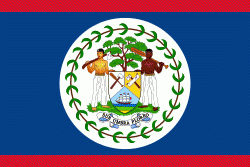Flag of Belize
The flag of Belize was adopted on 21 September 1981, the day Belize became independent. It consists of the Coat of Arms on a blue field with red stripes at the top and bottom.
British Honduras obtained a coat of arms on 28 January 1907, which formed the basis of the badge used on British ensigns. The coat of arms recalls the logging industry that first led to British settlement there. The figures, tools, and mahogany trees represent this industry. The national motto, Sub Umbra Floreo, meaning "Under the Shade I Flourish", is written in the lower part of the coat of arms.
The flag is royal blue, with a white disc at the centre containing the national coat of arms held by a mestizo and a man of African descent. The flag of Belize is the only country to have humans depicted as a major design element on its national flag, although the flag of Malta contains an image of Saint George on the badge of the George Cross, and the flags of British overseas territories Montserrat and the Virgin Islands, and that of French Polynesia also depict humans.
Several other countries' flags have human body parts depicted. The flag of Brunei has human hands, and the flags of Uruguay and Argentina both have human facial features depicted in a personified sun.
The flag is bordered at top and bottom by two red stripes. In all, the flag incorporates 19 different colours and shades, making it one of the most colourful national flags in the world.
The colours on the flag are respectively those of the country's national parties, the People's United Party (PUP), and United Democratic Party (Belize) (UDP). The UDP, established in 1973, had objected to the original blue and white design, those two colours being the PUP's representative colours.
The two red stripes at the top and bottom were added to the original design at independence. The coat of arms was granted in 1907. Red stripes were added to denote the colour of the opposition party. The 50 leaves recall 1950, the year PUP came to power.
British Honduras obtained a coat of arms on 28 January 1907, which formed the basis of the badge used on British ensigns. The coat of arms recalls the logging industry that first led to British settlement there. The figures, tools, and mahogany trees represent this industry. The national motto, Sub Umbra Floreo, meaning "Under the Shade I Flourish", is written in the lower part of the coat of arms.
The flag is royal blue, with a white disc at the centre containing the national coat of arms held by a mestizo and a man of African descent. The flag of Belize is the only country to have humans depicted as a major design element on its national flag, although the flag of Malta contains an image of Saint George on the badge of the George Cross, and the flags of British overseas territories Montserrat and the Virgin Islands, and that of French Polynesia also depict humans.
Several other countries' flags have human body parts depicted. The flag of Brunei has human hands, and the flags of Uruguay and Argentina both have human facial features depicted in a personified sun.
The flag is bordered at top and bottom by two red stripes. In all, the flag incorporates 19 different colours and shades, making it one of the most colourful national flags in the world.
The colours on the flag are respectively those of the country's national parties, the People's United Party (PUP), and United Democratic Party (Belize) (UDP). The UDP, established in 1973, had objected to the original blue and white design, those two colours being the PUP's representative colours.
The two red stripes at the top and bottom were added to the original design at independence. The coat of arms was granted in 1907. Red stripes were added to denote the colour of the opposition party. The 50 leaves recall 1950, the year PUP came to power.
National flag
Country - Belize
Warning: getimagesize(/Image/Map/MP3582678.gif): failed to open stream: No such file or directory in /home/mapnlee7/public_html/MAPNALL/article.php on line 532
 |
 |
The Maya civilization spread into the area of Belize between 1500 BC and AD 300 and flourished until about 1200. European contact began in 1492 when Christopher Columbus sailed along the Gulf of Honduras. European exploration was begun by English settlers in 1638. Spain and Britain both laid claim to the land until Britain defeated the Spanish in the Battle of St. George's Caye (1798). In 1840 it became a British colony known as British Honduras, and a Crown colony in 1862. Belize achieved its independence from the United Kingdom on 21 September 1981. It is the only mainland Central American country which is a Commonwealth realm, with King Charles III as its monarch and head of state, represented by a governor-general.
